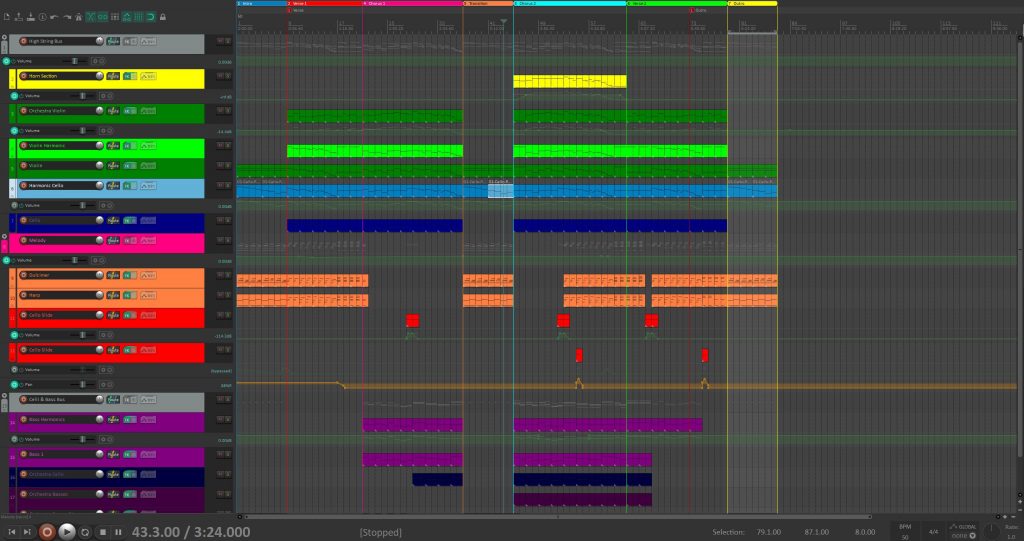The Viking Village Part IV: The Soundtrack

Here we are, the music. If you haven’t learned about the project I’m working on already, read more about it in the previous posts. The instrumentation I decided on was solo Horn in F, Dulcimer, Harp, and string orchestra.
The string orchestra, especially the basses and celli, provide with a nice ominous sound for a repeating transition, functioning as an intro or bridge throughout the piece.
First I wrote the piece out fully. It’s about a 6 minute track with a verse and a chorus varying in intensity and instrumentation. The harp and dulcimer are simple and really provide the rhythm for the piece. There are plenty of moments in the music where the plucked instruments are at rest, so there’s a lot of “floating” feeling in the legato strings.

It’s a very simple melody. This isn’t a bustling city, it’s a quiet village on the edge of a country, so the music needed to be simple and slow. I get to borrow from our sound culture norms. Using string orchestra has its advantages in making us feel this atmosphere, think Vaughan Williams, Delius, or Finzi…it’s a very British sound.
I did, however, want a somewhat heroic section for the player. You are the hero in the game after all, so this is a sort of call of the wild for you! Of course that’s in the horn, why would you even ask? Centuries of music culture have told us that the hero is in the horn. Just ask Wagner, Strauss, Mahler, and everyone else.
So is this a real orchestra?
No. My work in this scene has literally no budget. When I compose for performance, I often use a keyboard and Finale. I do all of my copyist work in Finale. Why? Because that’s where I started and why the hell would I spend the zillions of hours it took to learn on something new. I kind of hate to say, well this is the way we’ve always done it, but honestly, it’s the truth. I first bought Finale in 2005 and have worked myself up to being proficient in the program, so I don’t think I can turn back 15 years later.
For my recorded music, commercial music, or anything that is going to be mixed with media, I use Reaper. Reaper is my DAW. Lots of people love ProTools, Logic, and all the other sorts of DAWS. But my experience with Reaper has been wonderful. It’s a lightweight software that really doesn’t need to buffer. That really is important to me when time actually = money. I also love the common updates and of course the price point. Additionally I should mention that the community is terrific. People have answered so many questions for me on Reddit about Reaper and the folks who use it really believe in it. That’s just wonderful these days.

I have actually built a nice library of sounds that I use for projects in my DAW. I use the Garritan Professional Orchestra a lot of the time as well as some other random VST’s I’ve acquired. If you’re searching for sounds, I recommend Spitfire Audio. They produc some great and easy-to-use products. The high harmonic strings in this piece are from Spitfire Audio. Now if you’re a musician you’re probably thinking “ugh fake instruments, that sucks!”. Sure, it’s not ideal and if I had all the money in the world, I would just hire musicians to record every piece I write, but again this is a learning project, not a performance.
I also know that the Garritan Orchestra is not the best sounding orchestra in the world. There are definitely better options out there. But at the time of purchase, it was what I could afford, so it’s what I work with for now. I hope to upgrade soon, but it’s a matter of priorities.
In the mix I have some VST’s doing harmonics, I have a cello sliding from one note to another, and I have reverb. I actually got a new reverb recently from Native Instruments, so I’m going to change the reverb at some point. The sounds that carry over actually made the cuts between the verse, chorus, and transitions impossible. There’s altogether too much going on in this music for the loops to work well. So now I have a nice sounding 6 minute piece that works straight played through.
However, the goal was to compose non-linear music that can be cued at any point. In order to fix the issue of the cuts from one section to another, I will now have to recompose the piece. That story in my next post.
Here is the full six-minute track. I should mention that this is not mastered or mixed in final condition. I went back and forth on whether to put up an early version of the track or not, and decided that an unpolished version was best for this blog post. It’s a little vulnerable to share an unfinished product, but I believe it helps show the process it takes to make things sound good.




